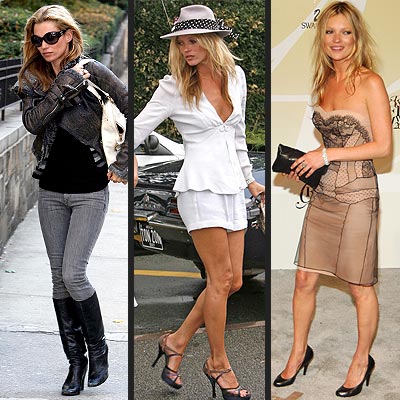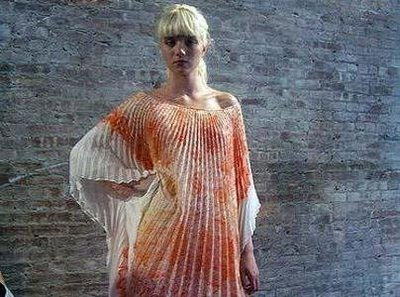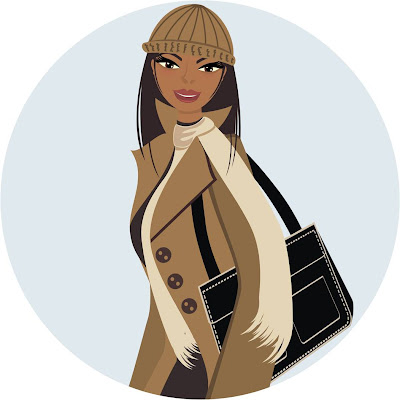 Last year during the January 2008 fashion week...
Last year during the January 2008 fashion week...'There should be more than one spot for a black model," says Yordanos Teshager, 21, a reed-thin, nearly 6-foot-tall model from Ethiopia who is represented by the prestigious Elite agency. But despite going on 85 cast calls seeking work during Fashion Week last season, she says she often left feeling that "they were going to hire a white girl."
Teshager walked in only 11 of some 200 shows last September, a season in which, overall, women of color were glaringly absent. Of the 101 shows and presentations, more than a third employed no black models.
Models were a homogeneous bunch - overwhelmingly white, bony and often blond. Along with the obvious - and serious - issue of racism, some wondered whether it wasn't all becoming just a little boring. When Fashion Week comes to town observers won't just be looking at the clothes - they'll also be looking for a serious change in who's wearing them.
"I would hope some of the designers would mix it up this season. Unless you were Eastern European, white, extremely skinny ... you didn't fit into the shows last season," says Nigel Barker, the photographer and judge on TV's "America's Next Top Model."
"Some shows had just one black model," Barker says, adding that he found the shows monotonous, visually unexciting and depressing. "Fashion is about fantasy, and everybody's fantasy is not to be 6 feet and white."
"I think designers will be more mindful," says Jasmine H. Chang, executive fashion editor of O, the Oprah Magazine. Chang says the absence of black models last season made her feel "uncomfortable. Here I am seated in an audience with every ethnicity in the world, and I did feel it was wrong."
 Efforts from the inside
Efforts from the insideIf there is a change, it will be in no small part because of the efforts of former model and agent Bethann Hardison, who has organized three panel discussions since September on the lack of diversity on runways. And it's a problem that's been building, she says. "It's not just a bad year, it's been a bad decade."
Who does she blame for the runway whiteout? "I blame us all - the designers, the agents, myself. ... But for me it all starts with the fashion designer," Hardison says. "They've gotten very 'Stepford Wives,' lost in commerce, very conservative. ... Where is the glamour? The avant-garde? I'm trying to get designers to stop following the yellow brick road."
Though she particularly advocates for African-Americans, Hardison says the problem affects all races and she vehemently objects to the apparent new taboo of looking different. "Forget even a white girl with style and personality. ... Fashion is going backwards." Bottom line, Hardison says, "The fashion designer no longer relates to the model, and I believe this is where I can raise consciousness and generate a sense of responsibility. It's race-based, and race conscious and that makes it unconsciously racist."
John Mincarelli, a longtime professor of fashion merchandising at the Fashion Institue of Technology in Manhattan, who takes a sociological view of fashion, agrees. "There's a complete lack of personality and that has to come from the designer. It's a dictate. Black models always bring personality to the runway."
Designer Carmen Marc Valvo, who dresses plenty of women of color including Vanessa Williams, Jennifer Hudson and Queen Latifah, says he's well aware of the issue and makes it his business to include a variety of ethnicities in his show. "It's almost as if the industry dictates this blond, blue-eyed ideal. We are very cognizant of this and always include women of color. I think it's almost criminal that one-third of the shows were all white."
 Blaming the agencies
Blaming the agenciesBut casting agent Jennifer Starr, who is also a judge on Bravo's "Make Me a
Supermodel" and is casting for Ralph Lauren, J Mendel, Alice Temperley and Carlos Miele, believes the problem stems from the modeling agencies.
"It's not the designers' fault ... at least the designers I work for," she says. "Ralph Lauren, especially, is constantly asking me why there aren't more African-American models he can put in his show." Starr says the agencies don't seek out African-American women of the same level as the white women they take on. She says she would hope that designers would want diversity, but, she adds, "I don't feel anyone should compromise their aesthetic just to be more representational. They should use the girls they love, whether that girl is white, black, Hispanic or Asian."
Likewise, Kate Armenta, the bookings editor at Vogue magazine, says, "The black presence has somewhat faded and there seems to be a lack of up-and-coming black women. We see some, but not enough." She adds that other racial groups are underrepresented as well.
Daul Kim, 18, a Korean model also at Elite, has felt the cold shoulder. In Paris last season, she was actually told at a casting that they were only hiring white women. "I think it was so rude," Kim says. Not to worry, though. This season, Kim was named one of the "Top 10 Models to Watch" by New York Magazine and is, according to her agent, "surging a bit in popularity."
Not surprisingly, modeling agencies don't want to take the blame for the dearth of diversity. Roman Young, the director of new faces at Elite, says, "We are doing our part. This is a blended office ethnically and culturally. I'm really passionate about the beauty spectrum." Young says that when a client asks for "the girl next door," he responds that "the girl next door to me was Filipino. ... Can I send a black girl?" Although he says he's fully aware that the client wants a white model, he notes that in the end, "It's my job to sell beauty not ethnicity."
 Getting behind change
Getting behind changeCalling for an end to all the finger pointing, Ivan Bart, senior vice president of powerhouse agency IMG models who represents black supermodels like
Tyra Banks, Alek Wek, Liya Kebede and
Naomi Campbell, says this should be "about the industry coming together and recognizing what the consumer wants. There's a diverse group of consumers out in America and we should be listening to them."
He is optimistic that this season's runways will feature more diversity. In fact, he says IMG has a slew of new ethnic talent to help fill the bill.
Ford Models president John Caplan adds, "Our role, and the role of the agent, is to scout for interesting faces of all ethnicities. ... The responsibility for who is successful comes down to what the marketplace wants." Well in advance of Fashion Week, Ford's superstar Chanel Iman Robinson, who was often the single black face in shows last season, was already reserved for most of the major shows.
For its part, the Council of Fashion Designers of America is taking a hands-off approach to the issue, though it did send members a letter that touched upon it by saying that "fashion can impact how individuals define themselves so it is the responsibility of the industry to take action to celebrate diversity."
Will it? Elite's Young has noticed "more girls of color on the request list this season." And that holds true at Ford, as well. Hardison is hopeful. "If I was dealing with homeland security, I know nothing would change. But I think it's going to make a difference. You got to keep on, keep on, keep on."
So will 2009 be more of the same? You'd hope the Obama effect would sink in and the fashion industry would suddenly realize black supermodels aren't just sexy, they're cool.
 FASHION - You don't want a lump of coal for Christmas, but a little black lace dress and the accessories to match might be on your list this year. Its sort of an old-fashioned Victorian Christmas idea, but don't forget black lace suffers from a Madonna/whore complex in fashion.
FASHION - You don't want a lump of coal for Christmas, but a little black lace dress and the accessories to match might be on your list this year. Its sort of an old-fashioned Victorian Christmas idea, but don't forget black lace suffers from a Madonna/whore complex in fashion. Prada believes in lace so much that she reportedly bought the entire stock produced from a Swiss factory. Small surprise, whatever the highly influential Prada does, it usually sends shock waves through the fashion world.
Prada believes in lace so much that she reportedly bought the entire stock produced from a Swiss factory. Small surprise, whatever the highly influential Prada does, it usually sends shock waves through the fashion world.


















































.jpg)
